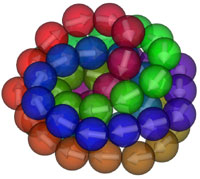Staff profile
Dr Mark Miller
Associate Professor

| Affiliation | Telephone |
|---|---|
| Associate Professor in the Department of Chemistry | +44 (0) 191 33 42037 |
Biography
Mark Miller read Natural Sciences at the University of Cambridge, and continued there to study for a Ph.D. on the energy landscapes and dynamics of model clusters under the supervision of Prof. David Wales. Mark then undertook postdoctoral work in the group of Prof. William Reinhardt at the University of Washington in Seattle, and in the group of Prof. Daan Frenkel at the Institute for Atomic and Molecular Physics (AMOLF) in Amsterdam. Mark returned to Cambridge initially as a Junior Research Fellow at Churchill College, then as an EPSRC Advanced Research Fellow and finally as a University Lecturer. In 2013 he moved to the Department of Chemistry at the University of Durham.
Research Interests
My research employs specially designed simulation techniques to investigate the structure, dynamics and thermodynamics of molecular and colloidal systems. A key element in my approach is the use of coarse-grained models that provide insight into a problem by being as simple as possible while retaining the essential chemistry and physics. Even with simplified models, it is often highly challenging to bridge the gap between the length- and time-scales associated with individual particles and those associated with collective properties. The development of simulation methodology is essential to make progress in such cases.
Self Assembly
Nature provides many examples of molecular building blocks that efficiently self-organise into well-defined structures, such as the cooperative folding and assembly of proteins into highly specific complexes, and the assembly of the protein shells (capsids) that encapsulate the genetic material of viruses. Such processes are driven by the shapes and interactions of the individual components of the final structure, and by the conditions in which they encounter one another. We are using modelling and simulation techniques to investigate the rules for, and limits of self assembly with the goal of learning how to design particles that will self-assemble into target structures with minimal intervention.
Clusters

Small aggregates of molecules or colloidal particles often have properties that differ from the bulk (very large samples). As well as being important in their own right, such finite systems can also be a useful forum for investigating how the interactions between particles lead to their collective behaviour. Two examples of work on clusters that we are currently considering are the formation of knotted structures formed in clusters of dipolar particles, and the stability of charged clusters relevant to electrospray processes.
Network-forming fluids

The characteristics of disordered phases can often be described by the nature of the aggregates that they contain. Aggregates may be compact or diffuse and may grow large enough to percolate (i.e., to span the entire system). For example, gels are low-density networks of particles that have become connected, possibly transiently, resulting in slower dynamic relaxation of the structure. In systems of electrically conducting particles there is a sharp increase in the conductivity of the entire sample under conditions where the particles connect into a percolating network.
Selected Publications
- Automated coarse-grained mapping algorithm for the Martini force field and benchmarks for membrane-water partitioning; T. D. Potter, E. L. Barrett and M. A. Miller; J. Chem. Theor. Comput. 17 5777 (2021)
- Control of superselectivity by crowding in three-dimensional hosts; A. T. R. Christy, H. Kusumaatmaja and M. A. Miller; Phys. Rev. Lett. 126 038002 (2021)
- Phase transitions on non-uniformly curved surfaces: coupling between phase and location; J. O. Law, J. M. Dean, M. A. Miller and H. Kusumaatmaja; Soft Matter 16 8069 (2020)
- Controlling fragment competition on pathways to addressable self-assembly; J. Madge, D. Bourne and M. A. Miller; J. Phys. Chem. B 122 9815 (2018)
- Knot theory in modern chemistry; K. E. Horner, M. A. Miller, J. W. Steed and P. M. Sutcliffe; Chem. Soc. Rev. 45 6432 (2016)
- Percolation in suspensions of hard nanoparticles: From spheres to needles; T. Schilling, M. A. Miller and P. van der Schoot; Europhys. Lett. 111 56004 (2015)
Research interests
- Soft condensed matter
- Atomic and molecular clusters
- Self assembly
- Monte Carlo simulation
Publications
Chapter in book
Journal Article
- Evans, D., Martín-Roca, J., Harmer, N. J., Valeriani, C., & Miller, M. A. (2024). Re-entrant percolation in active Brownian hard disks. Soft Matter, 20(37), 7484-7492. https://doi.org/10.1039/d4sm00975d
- Potter, T. D., Haywood, N., Teixeira, A., Hodges, G., Barrett, E. L., & Miller, M. A. (2023). Partitioning into phosphatidylcholine-cholesterol membranes: liposome measurements, coarse-grained simulations, and implications for bioaccumulation. Environmental Science: Processes & Impacts, 25(6), 1082-1093. https://doi.org/10.1039/d3em00081h
- Potter, T. D., Barrett, E. L., & Miller, M. A. (2021). Automated Coarse-Grained Mapping Algorithm for the Martini Force Field and Benchmarks for Membrane–Water Partitioning. Journal of Chemical Theory and Computation, 17(9), 5777-5791. https://doi.org/10.1021/acs.jctc.1c00322
- Coupette, F., de Bruijn, R., Bult, P., Finner, S., Miller, M. A., van der Schoot, P., & Schilling, T. (2021). Nearest-neighbor connectedness theory: A general approach to continuum percolation. Physical Review E, 103(4), Article 042115. https://doi.org/10.1103/physreve.103.042115
- Christy, A. T., Kusumaatmaja, H., & Miller, M. A. (2021). Control of Superselectivity by Crowding in Three-Dimensional Hosts. Physical Review Letters, 126(2), Article 028002. https://doi.org/10.1103/physrevlett.126.028002
- Law, J. O., Dean, J. M., Miller, M. A., & Kusumaatmaja, H. (2020). Phase transitions on non-uniformly curved surfaces: Coupling between phase and location. Soft Matter, 16(34), 8069-8077. https://doi.org/10.1039/d0sm00652a
- Madge, J., Bourne, D., & Miller, M. A. (2018). Controlling Fragment Competition on Pathways to Addressable Self-Assembly. Journal of Physical Chemistry B (Soft Condensed Matter and Biophysical Chemistry), 122(42), 9815-9825. https://doi.org/10.1021/acs.jpcb.8b08096
- Law, J. O., Wong, A. G., Kusumaatmaja, H., & Miller, M. A. (2018). Nucleation on a sphere: the roles of curvature, confinement and ensemble. Molecular Physics, 116(21-22), 3008-3019. https://doi.org/10.1080/00268976.2018.1483041
- Finner, S. P., Kotsev, M. I., Miller, M. A., & van der Schoot, P. (2018). Continuum percolation of polydisperse rods in quadrupole fields: Theory and simulations. The Journal of Chemical Physics, 148(3), Article 034903. https://doi.org/10.1063/1.5010979
- Madge, J., & Miller, M. A. (2017). Optimising Minimal Building Blocks for Addressable Self-Assembly. Soft Matter, 13(42), 7780-7792. https://doi.org/10.1039/c7sm01646h
- Horner, K. E., Miller, M. A., Steed, J. W., & Sutcliffe, P. M. (2016). Knot theory in modern chemistry. Chemical Society Reviews, 45(23), 6432-6448. https://doi.org/10.1039/c6cs00448b
- Castilla, A., Miller, M., Nitschke, J., & Smulders, M. (2016). Quantification of Stereochemical Communication in Metal–Organic Assemblies. Angewandte Chemie International Edition, 55(36), 10616-10620. https://doi.org/10.1002/anie.201602968
- Coluzza, I., Jackson, S. E., Micheletti, C., & Miller, M. A. (2015). Knots in soft condensed matter. Journal of Physics: Condensed Matter, 27(35), Article 350301. https://doi.org/10.1088/0953-8984/27/35/350301
- Schilling, T., Miller, M. A., & van der Schoot, P. (2015). Percolation in suspensions of hard nanoparticles: From spheres to needles. European Physical Society Letters, 111(5), Article 56004. https://doi.org/10.1209/0295-5075/111/56004
- Miller, M. A., Bonhommeau, D. A., Moerland, C. P., Gray, S. J., & Gaigeot, M.-P. (2015). Dynamics and thermodynamics of decay in charged clusters. Molecular Physics, 113(17-18), 2428-2434. https://doi.org/10.1080/00268976.2015.1037805
- Madge, J., & Miller, M. A. (2015). Design strategies for self-assembly of discrete targets. The Journal of Chemical Physics, 143(4), Article 044905. https://doi.org/10.1063/1.4927671
- Wales, D., Miller, M., & Walsh, T. (1998). Archetypal energy landscapes. Nature, 394(6695), 758-760. https://doi.org/10.1038/29487

